Advocacy Through Legislation: Addressing Hospital Acquired Infections
VerifiedAdded on 2022/08/19
|8
|2298
|19
Homework Assignment
AI Summary
This assignment examines the issue of hospital-acquired infections (HAIs) in Texas, detailing the problem's scope, affected parties, and consequences. The student proposes legislative advocacy as a solution, emphasizing the need for public support and government intervention. The research includes evidence of similar legislation in other states, such as Alabama and Arizona, demonstrating the effectiveness of legislative measures in reducing HAI rates. The assignment identifies stakeholders, including the government and the population, who would support the proposal due to the economic and health benefits. Conversely, healthcare organizations and insurance providers may oppose the idea due to potential costs and policy changes. The financial impact analysis highlights the increased healthcare costs associated with HAIs, supporting the need for intervention strategies. The assignment outlines the process of advocating for the proposal through legislation, including steps for presenting the idea to a legislator. The assignment concludes by discussing how Christian principles support legislative advocacy in healthcare, promoting inclusiveness and positive health outcomes for all populations.
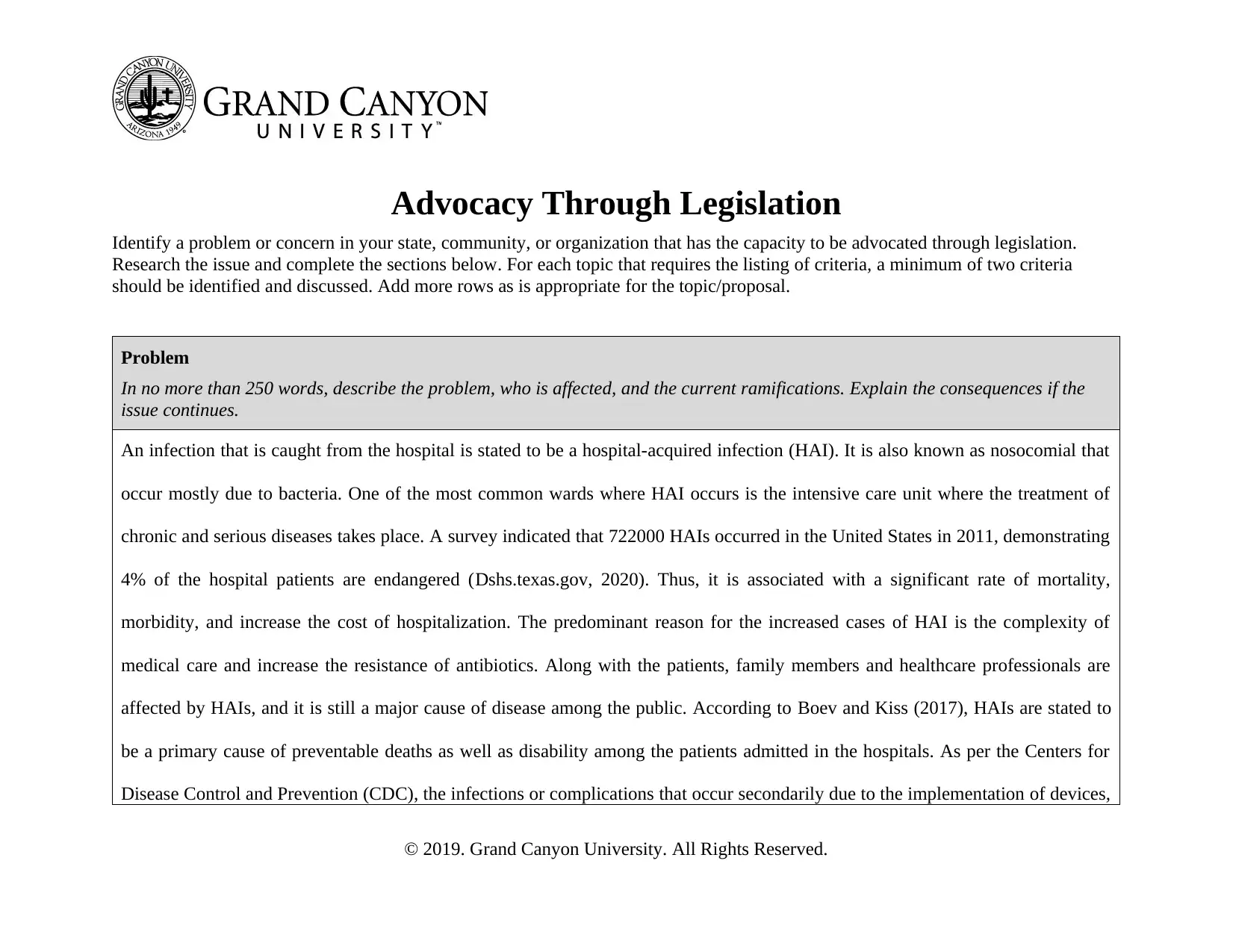
Advocacy Through Legislation
Identify a problem or concern in your state, community, or organization that has the capacity to be advocated through legislation.
Research the issue and complete the sections below. For each topic that requires the listing of criteria, a minimum of two criteria
should be identified and discussed. Add more rows as is appropriate for the topic/proposal.
Problem
In no more than 250 words, describe the problem, who is affected, and the current ramifications. Explain the consequences if the
issue continues.
An infection that is caught from the hospital is stated to be a hospital-acquired infection (HAI). It is also known as nosocomial that
occur mostly due to bacteria. One of the most common wards where HAI occurs is the intensive care unit where the treatment of
chronic and serious diseases takes place. A survey indicated that 722000 HAIs occurred in the United States in 2011, demonstrating
4% of the hospital patients are endangered (Dshs.texas.gov, 2020). Thus, it is associated with a significant rate of mortality,
morbidity, and increase the cost of hospitalization. The predominant reason for the increased cases of HAI is the complexity of
medical care and increase the resistance of antibiotics. Along with the patients, family members and healthcare professionals are
affected by HAIs, and it is still a major cause of disease among the public. According to Boev and Kiss (2017), HAIs are stated to
be a primary cause of preventable deaths as well as disability among the patients admitted in the hospitals. As per the Centers for
Disease Control and Prevention (CDC), the infections or complications that occur secondarily due to the implementation of devices,
© 2019. Grand Canyon University. All Rights Reserved.
Identify a problem or concern in your state, community, or organization that has the capacity to be advocated through legislation.
Research the issue and complete the sections below. For each topic that requires the listing of criteria, a minimum of two criteria
should be identified and discussed. Add more rows as is appropriate for the topic/proposal.
Problem
In no more than 250 words, describe the problem, who is affected, and the current ramifications. Explain the consequences if the
issue continues.
An infection that is caught from the hospital is stated to be a hospital-acquired infection (HAI). It is also known as nosocomial that
occur mostly due to bacteria. One of the most common wards where HAI occurs is the intensive care unit where the treatment of
chronic and serious diseases takes place. A survey indicated that 722000 HAIs occurred in the United States in 2011, demonstrating
4% of the hospital patients are endangered (Dshs.texas.gov, 2020). Thus, it is associated with a significant rate of mortality,
morbidity, and increase the cost of hospitalization. The predominant reason for the increased cases of HAI is the complexity of
medical care and increase the resistance of antibiotics. Along with the patients, family members and healthcare professionals are
affected by HAIs, and it is still a major cause of disease among the public. According to Boev and Kiss (2017), HAIs are stated to
be a primary cause of preventable deaths as well as disability among the patients admitted in the hospitals. As per the Centers for
Disease Control and Prevention (CDC), the infections or complications that occur secondarily due to the implementation of devices,
© 2019. Grand Canyon University. All Rights Reserved.
Paraphrase This Document
Need a fresh take? Get an instant paraphrase of this document with our AI Paraphraser
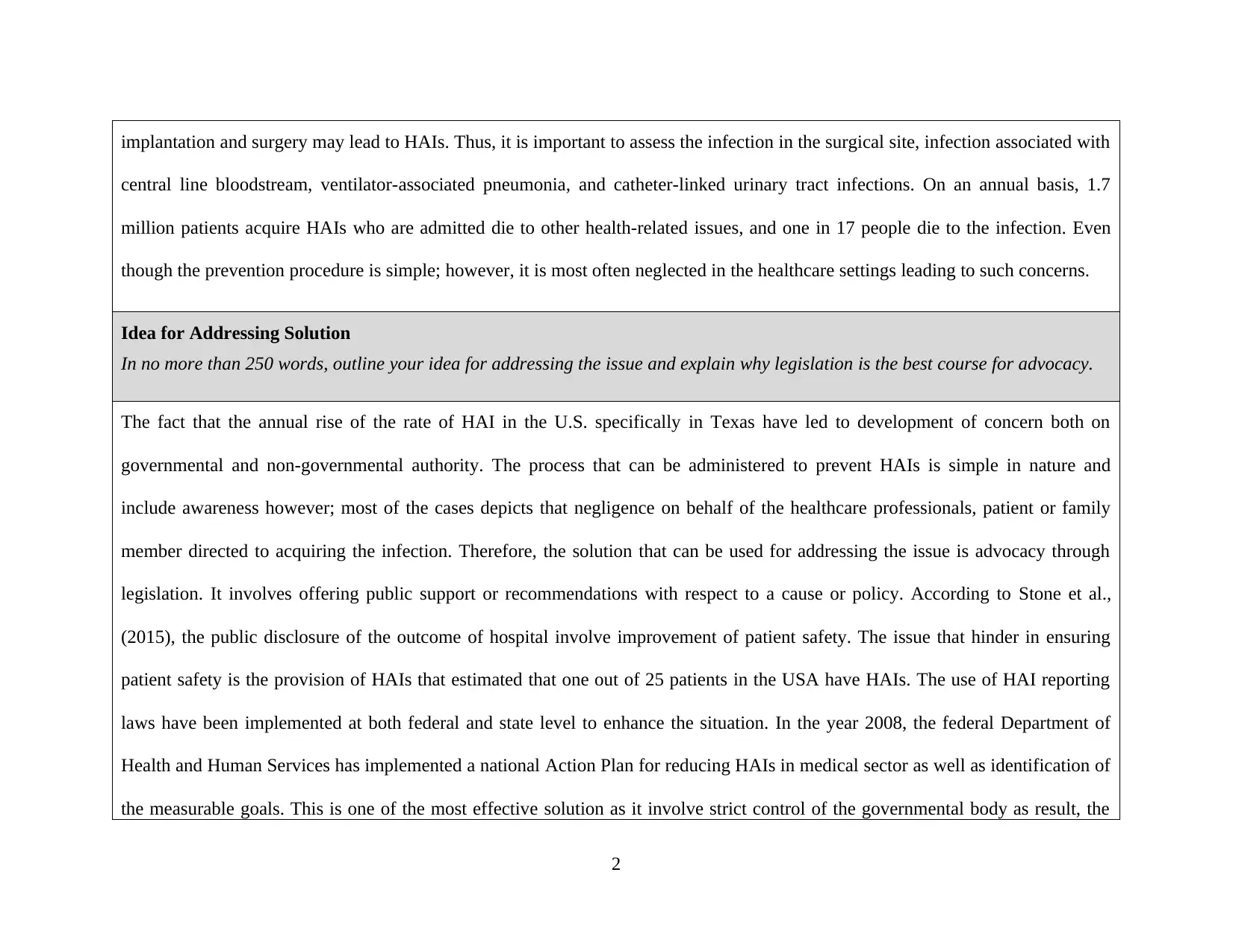
implantation and surgery may lead to HAIs. Thus, it is important to assess the infection in the surgical site, infection associated with
central line bloodstream, ventilator-associated pneumonia, and catheter-linked urinary tract infections. On an annual basis, 1.7
million patients acquire HAIs who are admitted die to other health-related issues, and one in 17 people die to the infection. Even
though the prevention procedure is simple; however, it is most often neglected in the healthcare settings leading to such concerns.
Idea for Addressing Solution
In no more than 250 words, outline your idea for addressing the issue and explain why legislation is the best course for advocacy.
The fact that the annual rise of the rate of HAI in the U.S. specifically in Texas have led to development of concern both on
governmental and non-governmental authority. The process that can be administered to prevent HAIs is simple in nature and
include awareness however; most of the cases depicts that negligence on behalf of the healthcare professionals, patient or family
member directed to acquiring the infection. Therefore, the solution that can be used for addressing the issue is advocacy through
legislation. It involves offering public support or recommendations with respect to a cause or policy. According to Stone et al.,
(2015), the public disclosure of the outcome of hospital involve improvement of patient safety. The issue that hinder in ensuring
patient safety is the provision of HAIs that estimated that one out of 25 patients in the USA have HAIs. The use of HAI reporting
laws have been implemented at both federal and state level to enhance the situation. In the year 2008, the federal Department of
Health and Human Services has implemented a national Action Plan for reducing HAIs in medical sector as well as identification of
the measurable goals. This is one of the most effective solution as it involve strict control of the governmental body as result, the
2
central line bloodstream, ventilator-associated pneumonia, and catheter-linked urinary tract infections. On an annual basis, 1.7
million patients acquire HAIs who are admitted die to other health-related issues, and one in 17 people die to the infection. Even
though the prevention procedure is simple; however, it is most often neglected in the healthcare settings leading to such concerns.
Idea for Addressing Solution
In no more than 250 words, outline your idea for addressing the issue and explain why legislation is the best course for advocacy.
The fact that the annual rise of the rate of HAI in the U.S. specifically in Texas have led to development of concern both on
governmental and non-governmental authority. The process that can be administered to prevent HAIs is simple in nature and
include awareness however; most of the cases depicts that negligence on behalf of the healthcare professionals, patient or family
member directed to acquiring the infection. Therefore, the solution that can be used for addressing the issue is advocacy through
legislation. It involves offering public support or recommendations with respect to a cause or policy. According to Stone et al.,
(2015), the public disclosure of the outcome of hospital involve improvement of patient safety. The issue that hinder in ensuring
patient safety is the provision of HAIs that estimated that one out of 25 patients in the USA have HAIs. The use of HAI reporting
laws have been implemented at both federal and state level to enhance the situation. In the year 2008, the federal Department of
Health and Human Services has implemented a national Action Plan for reducing HAIs in medical sector as well as identification of
the measurable goals. This is one of the most effective solution as it involve strict control of the governmental body as result, the
2
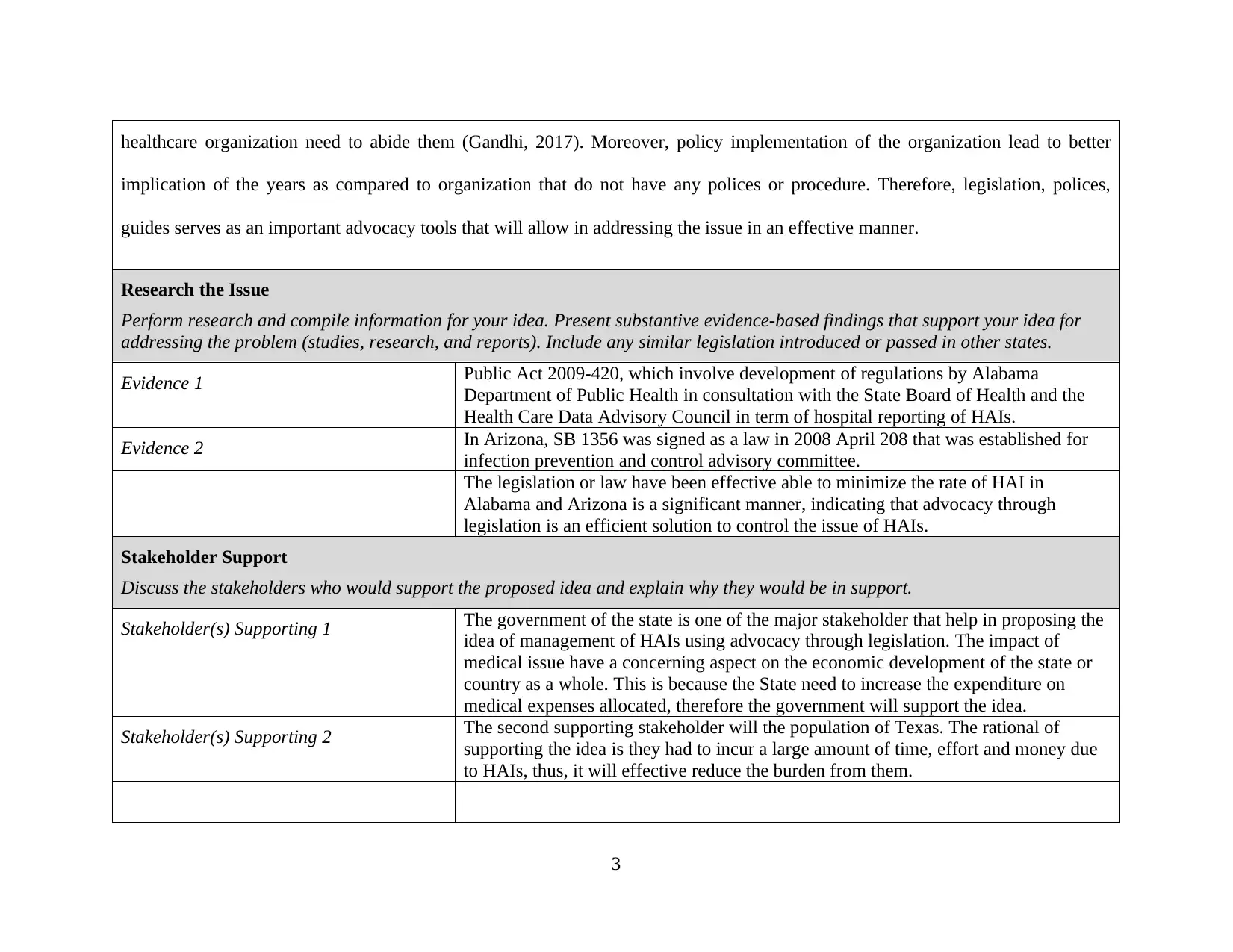
healthcare organization need to abide them (Gandhi, 2017). Moreover, policy implementation of the organization lead to better
implication of the years as compared to organization that do not have any polices or procedure. Therefore, legislation, polices,
guides serves as an important advocacy tools that will allow in addressing the issue in an effective manner.
Research the Issue
Perform research and compile information for your idea. Present substantive evidence-based findings that support your idea for
addressing the problem (studies, research, and reports). Include any similar legislation introduced or passed in other states.
Evidence 1 Public Act 2009-420, which involve development of regulations by Alabama
Department of Public Health in consultation with the State Board of Health and the
Health Care Data Advisory Council in term of hospital reporting of HAIs.
Evidence 2 In Arizona, SB 1356 was signed as a law in 2008 April 208 that was established for
infection prevention and control advisory committee.
The legislation or law have been effective able to minimize the rate of HAI in
Alabama and Arizona is a significant manner, indicating that advocacy through
legislation is an efficient solution to control the issue of HAIs.
Stakeholder Support
Discuss the stakeholders who would support the proposed idea and explain why they would be in support.
Stakeholder(s) Supporting 1 The government of the state is one of the major stakeholder that help in proposing the
idea of management of HAIs using advocacy through legislation. The impact of
medical issue have a concerning aspect on the economic development of the state or
country as a whole. This is because the State need to increase the expenditure on
medical expenses allocated, therefore the government will support the idea.
Stakeholder(s) Supporting 2 The second supporting stakeholder will the population of Texas. The rational of
supporting the idea is they had to incur a large amount of time, effort and money due
to HAIs, thus, it will effective reduce the burden from them.
3
implication of the years as compared to organization that do not have any polices or procedure. Therefore, legislation, polices,
guides serves as an important advocacy tools that will allow in addressing the issue in an effective manner.
Research the Issue
Perform research and compile information for your idea. Present substantive evidence-based findings that support your idea for
addressing the problem (studies, research, and reports). Include any similar legislation introduced or passed in other states.
Evidence 1 Public Act 2009-420, which involve development of regulations by Alabama
Department of Public Health in consultation with the State Board of Health and the
Health Care Data Advisory Council in term of hospital reporting of HAIs.
Evidence 2 In Arizona, SB 1356 was signed as a law in 2008 April 208 that was established for
infection prevention and control advisory committee.
The legislation or law have been effective able to minimize the rate of HAI in
Alabama and Arizona is a significant manner, indicating that advocacy through
legislation is an efficient solution to control the issue of HAIs.
Stakeholder Support
Discuss the stakeholders who would support the proposed idea and explain why they would be in support.
Stakeholder(s) Supporting 1 The government of the state is one of the major stakeholder that help in proposing the
idea of management of HAIs using advocacy through legislation. The impact of
medical issue have a concerning aspect on the economic development of the state or
country as a whole. This is because the State need to increase the expenditure on
medical expenses allocated, therefore the government will support the idea.
Stakeholder(s) Supporting 2 The second supporting stakeholder will the population of Texas. The rational of
supporting the idea is they had to incur a large amount of time, effort and money due
to HAIs, thus, it will effective reduce the burden from them.
3
⊘ This is a preview!⊘
Do you want full access?
Subscribe today to unlock all pages.

Trusted by 1+ million students worldwide
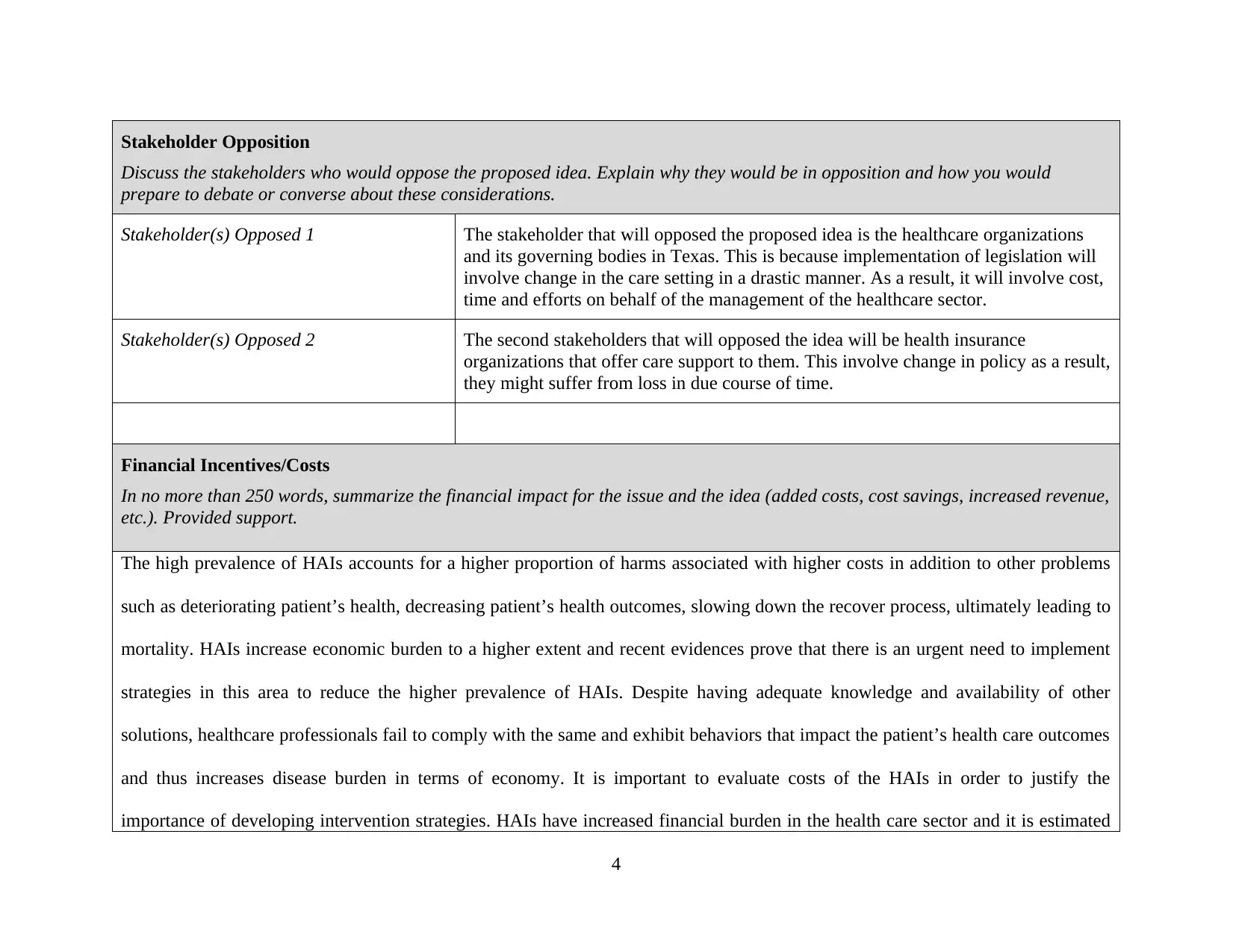
Stakeholder Opposition
Discuss the stakeholders who would oppose the proposed idea. Explain why they would be in opposition and how you would
prepare to debate or converse about these considerations.
Stakeholder(s) Opposed 1 The stakeholder that will opposed the proposed idea is the healthcare organizations
and its governing bodies in Texas. This is because implementation of legislation will
involve change in the care setting in a drastic manner. As a result, it will involve cost,
time and efforts on behalf of the management of the healthcare sector.
Stakeholder(s) Opposed 2 The second stakeholders that will opposed the idea will be health insurance
organizations that offer care support to them. This involve change in policy as a result,
they might suffer from loss in due course of time.
Financial Incentives/Costs
In no more than 250 words, summarize the financial impact for the issue and the idea (added costs, cost savings, increased revenue,
etc.). Provided support.
The high prevalence of HAIs accounts for a higher proportion of harms associated with higher costs in addition to other problems
such as deteriorating patient’s health, decreasing patient’s health outcomes, slowing down the recover process, ultimately leading to
mortality. HAIs increase economic burden to a higher extent and recent evidences prove that there is an urgent need to implement
strategies in this area to reduce the higher prevalence of HAIs. Despite having adequate knowledge and availability of other
solutions, healthcare professionals fail to comply with the same and exhibit behaviors that impact the patient’s health care outcomes
and thus increases disease burden in terms of economy. It is important to evaluate costs of the HAIs in order to justify the
importance of developing intervention strategies. HAIs have increased financial burden in the health care sector and it is estimated
4
Discuss the stakeholders who would oppose the proposed idea. Explain why they would be in opposition and how you would
prepare to debate or converse about these considerations.
Stakeholder(s) Opposed 1 The stakeholder that will opposed the proposed idea is the healthcare organizations
and its governing bodies in Texas. This is because implementation of legislation will
involve change in the care setting in a drastic manner. As a result, it will involve cost,
time and efforts on behalf of the management of the healthcare sector.
Stakeholder(s) Opposed 2 The second stakeholders that will opposed the idea will be health insurance
organizations that offer care support to them. This involve change in policy as a result,
they might suffer from loss in due course of time.
Financial Incentives/Costs
In no more than 250 words, summarize the financial impact for the issue and the idea (added costs, cost savings, increased revenue,
etc.). Provided support.
The high prevalence of HAIs accounts for a higher proportion of harms associated with higher costs in addition to other problems
such as deteriorating patient’s health, decreasing patient’s health outcomes, slowing down the recover process, ultimately leading to
mortality. HAIs increase economic burden to a higher extent and recent evidences prove that there is an urgent need to implement
strategies in this area to reduce the higher prevalence of HAIs. Despite having adequate knowledge and availability of other
solutions, healthcare professionals fail to comply with the same and exhibit behaviors that impact the patient’s health care outcomes
and thus increases disease burden in terms of economy. It is important to evaluate costs of the HAIs in order to justify the
importance of developing intervention strategies. HAIs have increased financial burden in the health care sector and it is estimated
4
Paraphrase This Document
Need a fresh take? Get an instant paraphrase of this document with our AI Paraphraser
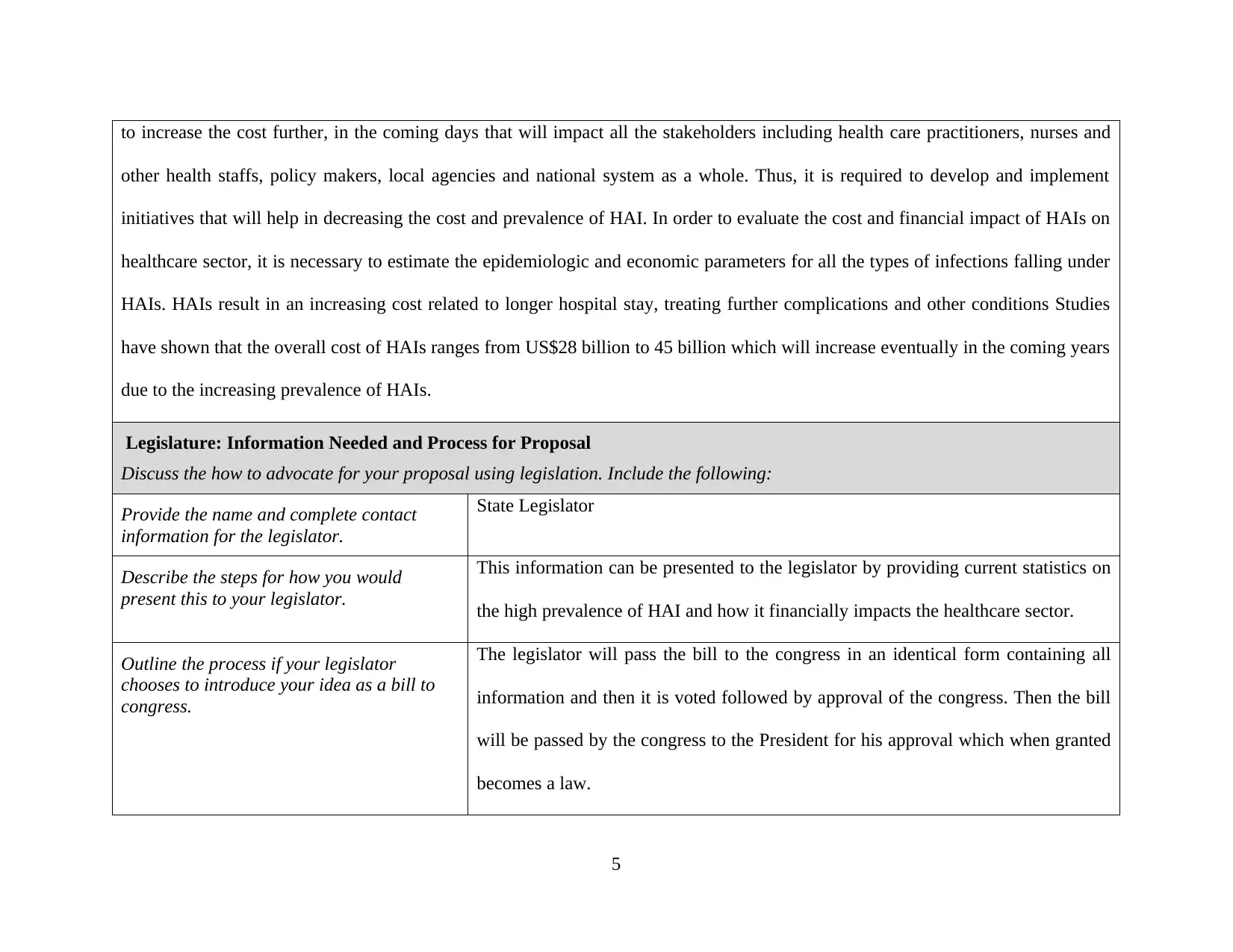
to increase the cost further, in the coming days that will impact all the stakeholders including health care practitioners, nurses and
other health staffs, policy makers, local agencies and national system as a whole. Thus, it is required to develop and implement
initiatives that will help in decreasing the cost and prevalence of HAI. In order to evaluate the cost and financial impact of HAIs on
healthcare sector, it is necessary to estimate the epidemiologic and economic parameters for all the types of infections falling under
HAIs. HAIs result in an increasing cost related to longer hospital stay, treating further complications and other conditions Studies
have shown that the overall cost of HAIs ranges from US$28 billion to 45 billion which will increase eventually in the coming years
due to the increasing prevalence of HAIs.
Legislature: Information Needed and Process for Proposal
Discuss the how to advocate for your proposal using legislation. Include the following:
Provide the name and complete contact
information for the legislator.
State Legislator
Describe the steps for how you would
present this to your legislator.
This information can be presented to the legislator by providing current statistics on
the high prevalence of HAI and how it financially impacts the healthcare sector.
Outline the process if your legislator
chooses to introduce your idea as a bill to
congress.
The legislator will pass the bill to the congress in an identical form containing all
information and then it is voted followed by approval of the congress. Then the bill
will be passed by the congress to the President for his approval which when granted
becomes a law.
5
other health staffs, policy makers, local agencies and national system as a whole. Thus, it is required to develop and implement
initiatives that will help in decreasing the cost and prevalence of HAI. In order to evaluate the cost and financial impact of HAIs on
healthcare sector, it is necessary to estimate the epidemiologic and economic parameters for all the types of infections falling under
HAIs. HAIs result in an increasing cost related to longer hospital stay, treating further complications and other conditions Studies
have shown that the overall cost of HAIs ranges from US$28 billion to 45 billion which will increase eventually in the coming years
due to the increasing prevalence of HAIs.
Legislature: Information Needed and Process for Proposal
Discuss the how to advocate for your proposal using legislation. Include the following:
Provide the name and complete contact
information for the legislator.
State Legislator
Describe the steps for how you would
present this to your legislator.
This information can be presented to the legislator by providing current statistics on
the high prevalence of HAI and how it financially impacts the healthcare sector.
Outline the process if your legislator
chooses to introduce your idea as a bill to
congress.
The legislator will pass the bill to the congress in an identical form containing all
information and then it is voted followed by approval of the congress. Then the bill
will be passed by the congress to the President for his approval which when granted
becomes a law.
5
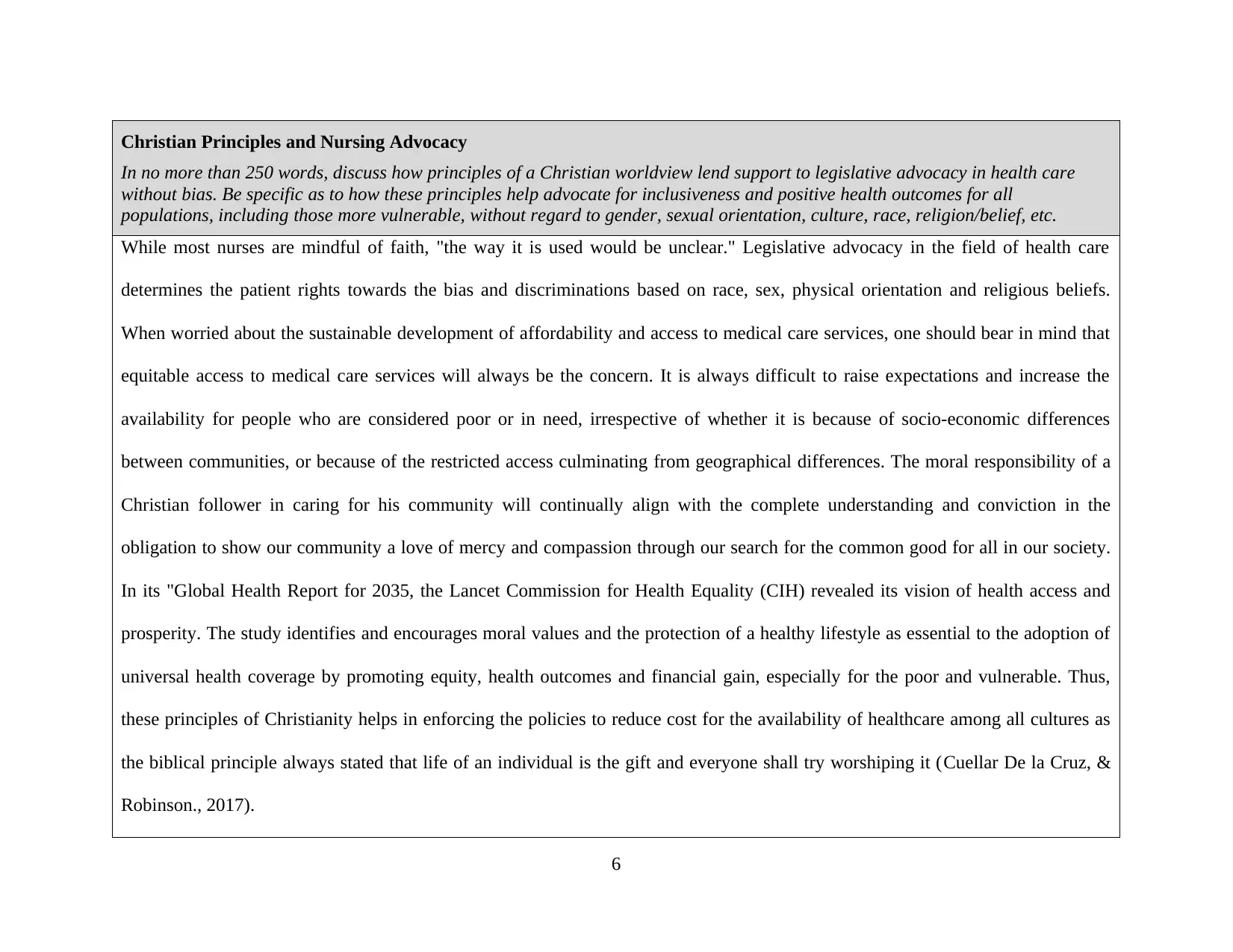
Christian Principles and Nursing Advocacy
In no more than 250 words, discuss how principles of a Christian worldview lend support to legislative advocacy in health care
without bias. Be specific as to how these principles help advocate for inclusiveness and positive health outcomes for all
populations, including those more vulnerable, without regard to gender, sexual orientation, culture, race, religion/belief, etc.
While most nurses are mindful of faith, "the way it is used would be unclear." Legislative advocacy in the field of health care
determines the patient rights towards the bias and discriminations based on race, sex, physical orientation and religious beliefs.
When worried about the sustainable development of affordability and access to medical care services, one should bear in mind that
equitable access to medical care services will always be the concern. It is always difficult to raise expectations and increase the
availability for people who are considered poor or in need, irrespective of whether it is because of socio-economic differences
between communities, or because of the restricted access culminating from geographical differences. The moral responsibility of a
Christian follower in caring for his community will continually align with the complete understanding and conviction in the
obligation to show our community a love of mercy and compassion through our search for the common good for all in our society.
In its "Global Health Report for 2035, the Lancet Commission for Health Equality (CIH) revealed its vision of health access and
prosperity. The study identifies and encourages moral values and the protection of a healthy lifestyle as essential to the adoption of
universal health coverage by promoting equity, health outcomes and financial gain, especially for the poor and vulnerable. Thus,
these principles of Christianity helps in enforcing the policies to reduce cost for the availability of healthcare among all cultures as
the biblical principle always stated that life of an individual is the gift and everyone shall try worshiping it (Cuellar De la Cruz, &
Robinson., 2017).
6
In no more than 250 words, discuss how principles of a Christian worldview lend support to legislative advocacy in health care
without bias. Be specific as to how these principles help advocate for inclusiveness and positive health outcomes for all
populations, including those more vulnerable, without regard to gender, sexual orientation, culture, race, religion/belief, etc.
While most nurses are mindful of faith, "the way it is used would be unclear." Legislative advocacy in the field of health care
determines the patient rights towards the bias and discriminations based on race, sex, physical orientation and religious beliefs.
When worried about the sustainable development of affordability and access to medical care services, one should bear in mind that
equitable access to medical care services will always be the concern. It is always difficult to raise expectations and increase the
availability for people who are considered poor or in need, irrespective of whether it is because of socio-economic differences
between communities, or because of the restricted access culminating from geographical differences. The moral responsibility of a
Christian follower in caring for his community will continually align with the complete understanding and conviction in the
obligation to show our community a love of mercy and compassion through our search for the common good for all in our society.
In its "Global Health Report for 2035, the Lancet Commission for Health Equality (CIH) revealed its vision of health access and
prosperity. The study identifies and encourages moral values and the protection of a healthy lifestyle as essential to the adoption of
universal health coverage by promoting equity, health outcomes and financial gain, especially for the poor and vulnerable. Thus,
these principles of Christianity helps in enforcing the policies to reduce cost for the availability of healthcare among all cultures as
the biblical principle always stated that life of an individual is the gift and everyone shall try worshiping it (Cuellar De la Cruz, &
Robinson., 2017).
6
⊘ This is a preview!⊘
Do you want full access?
Subscribe today to unlock all pages.

Trusted by 1+ million students worldwide

7
Paraphrase This Document
Need a fresh take? Get an instant paraphrase of this document with our AI Paraphraser
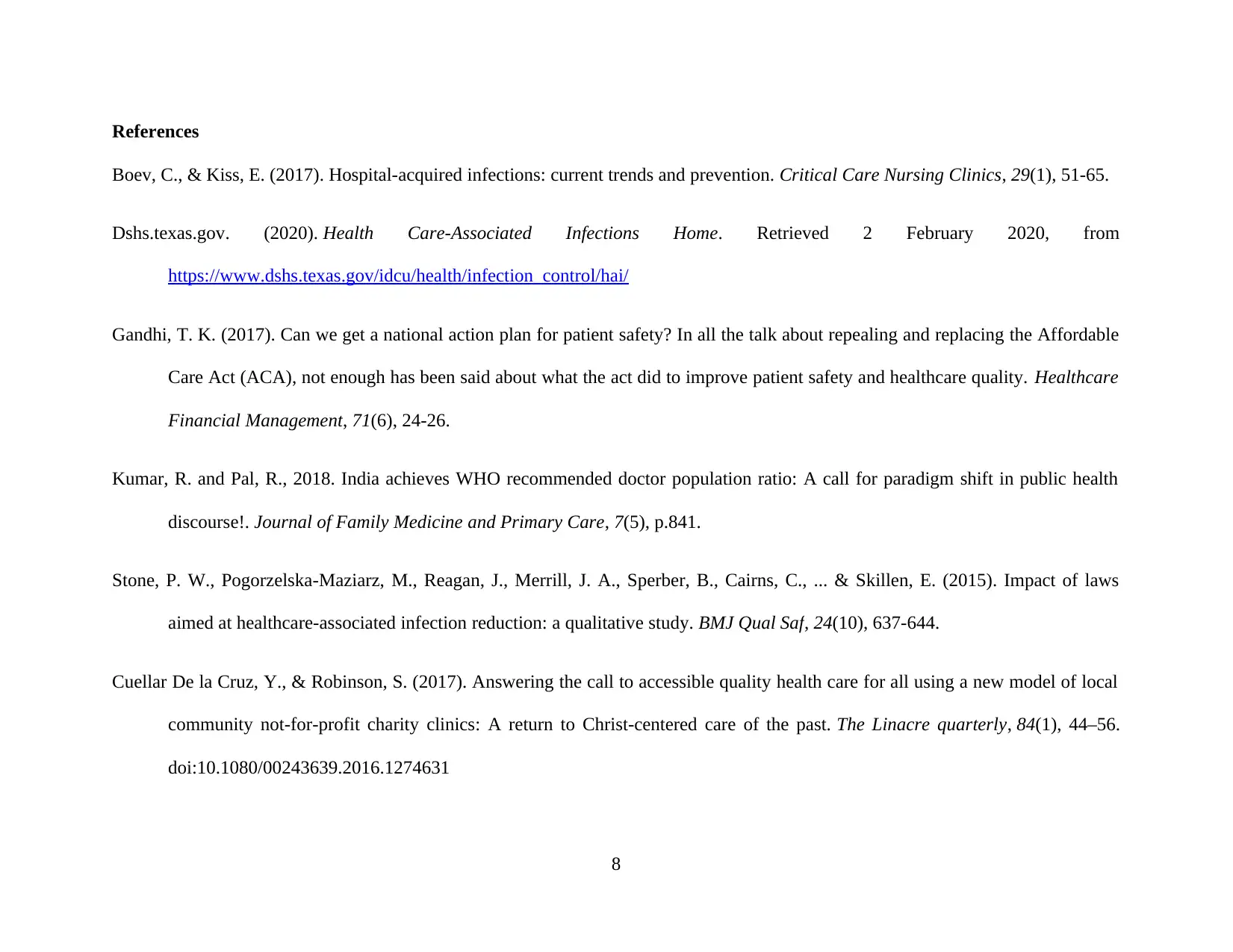
References
Boev, C., & Kiss, E. (2017). Hospital-acquired infections: current trends and prevention. Critical Care Nursing Clinics, 29(1), 51-65.
Dshs.texas.gov. (2020). Health Care-Associated Infections Home. Retrieved 2 February 2020, from
https://www.dshs.texas.gov/idcu/health/infection_control/hai/
Gandhi, T. K. (2017). Can we get a national action plan for patient safety? In all the talk about repealing and replacing the Affordable
Care Act (ACA), not enough has been said about what the act did to improve patient safety and healthcare quality. Healthcare
Financial Management, 71(6), 24-26.
Kumar, R. and Pal, R., 2018. India achieves WHO recommended doctor population ratio: A call for paradigm shift in public health
discourse!. Journal of Family Medicine and Primary Care, 7(5), p.841.
Stone, P. W., Pogorzelska-Maziarz, M., Reagan, J., Merrill, J. A., Sperber, B., Cairns, C., ... & Skillen, E. (2015). Impact of laws
aimed at healthcare-associated infection reduction: a qualitative study. BMJ Qual Saf, 24(10), 637-644.
Cuellar De la Cruz, Y., & Robinson, S. (2017). Answering the call to accessible quality health care for all using a new model of local
community not-for-profit charity clinics: A return to Christ-centered care of the past. The Linacre quarterly, 84(1), 44–56.
doi:10.1080/00243639.2016.1274631
8
Boev, C., & Kiss, E. (2017). Hospital-acquired infections: current trends and prevention. Critical Care Nursing Clinics, 29(1), 51-65.
Dshs.texas.gov. (2020). Health Care-Associated Infections Home. Retrieved 2 February 2020, from
https://www.dshs.texas.gov/idcu/health/infection_control/hai/
Gandhi, T. K. (2017). Can we get a national action plan for patient safety? In all the talk about repealing and replacing the Affordable
Care Act (ACA), not enough has been said about what the act did to improve patient safety and healthcare quality. Healthcare
Financial Management, 71(6), 24-26.
Kumar, R. and Pal, R., 2018. India achieves WHO recommended doctor population ratio: A call for paradigm shift in public health
discourse!. Journal of Family Medicine and Primary Care, 7(5), p.841.
Stone, P. W., Pogorzelska-Maziarz, M., Reagan, J., Merrill, J. A., Sperber, B., Cairns, C., ... & Skillen, E. (2015). Impact of laws
aimed at healthcare-associated infection reduction: a qualitative study. BMJ Qual Saf, 24(10), 637-644.
Cuellar De la Cruz, Y., & Robinson, S. (2017). Answering the call to accessible quality health care for all using a new model of local
community not-for-profit charity clinics: A return to Christ-centered care of the past. The Linacre quarterly, 84(1), 44–56.
doi:10.1080/00243639.2016.1274631
8
1 out of 8
Related Documents
Your All-in-One AI-Powered Toolkit for Academic Success.
+13062052269
info@desklib.com
Available 24*7 on WhatsApp / Email
![[object Object]](/_next/static/media/star-bottom.7253800d.svg)
Unlock your academic potential
Copyright © 2020–2025 A2Z Services. All Rights Reserved. Developed and managed by ZUCOL.




